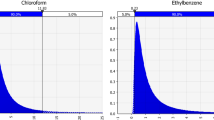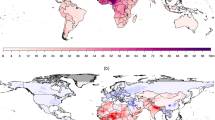Abstract
BRE has conducted a national representative survey of air pollutants in 876 homes in England, designed to increase knowledge of baseline pollutant levels and factors associated with high concentrations. Homes were monitored for carbon monoxide (CO), nitrogen dioxide (NO2), formaldehyde and volatile organic compounds (VOCs). In the majority of the homes, concentrations of the measured pollutants were low. However, some homes have concentrations that would suggest a need for precautionary mitigation. Those factors that are most likely to lead to exposures of concern in homes are identified as gas cooking (for CO and NO2), the use of unflued appliances for heating (for CO and NO2), emissions from materials in new homes (for total VOC (TVOC) and formaldehyde), and painting and decorating, with a significant increase in risk suspected to exist where there is not a place to store materials away from the living space (for TVOC). It is noteworthy that seasonal effects on CO and NO2 were largely due to indoor sources. This would need to be considered when interpreting time series studies of the effect of outdoor air pollution on health. It is also of some significance that the critical factors are related much more to sources than to ventilation: source control is therefore, as would be expected, the most appropriate approach to reducing the risk of hazardous exposure to air pollutants in homes.
This is a preview of subscription content, access via your institution
Access options
Subscribe to this journal
Receive 6 print issues and online access
$259.00 per year
only $43.17 per issue
Buy this article
- Purchase on Springer Link
- Instant access to full article PDF
Prices may be subject to local taxes which are calculated during checkout




Similar content being viewed by others
References
Apling A.J., Stevenson K.J., Goldstein B.D., Melia R.J.W., and Atkins D.H.F. Air pollution in homes 2: validation of diffusion tube measurements of nitrogen dioxide. Warren Spring Laboratory Report LR 311 (AP), WSL, Stevenage, 1979.
Atkins D.H.F., Healy C., and Tarrant J.B. The use of simple diffusion tubes for the measurement of nitrogen dioxide levels in homes using gas and electricity for cooking. AERE Report R9184, AERE Harwell, Oxfordshire, 1978.
Berry R.W., Brown V.M., Coward S.K.D., Crump D.R., Gavin M., Grimes C.P., Higham D.F., Hull A.V., Hunter C.A., Jeffery I.G., Lea R.G., Llewellyn J.W., and Raw G.J. Indoor air quality in homes. The BRE Indoor Environment Study. BRE Reports BR299 and BR300, CRC press, London, 1996.
Brown V.M., Crump D.R., and Mann H.S. The effect of measures to alleviate the symptoms of asthma on concentrations of VOCs and formaldehyde in UK homes. Proceedings of Indoor Air ‘96, Vol. 4, Indoor Air '96, Nagoya, 1996: pp. 69–74.
Brown V.M., Mann H.S., and Crump D.R. Formaldehyde and VOC levels in homes in England. Proceedings of Indoor Air 99, Vol. 4, CRC press, London, 1999: pp. 95–100.
Coward S.K.D., Brown V.M., Crump D.R., Raw G.J., and Llewellyn J.W. Indoor air quality in homes in England: volatile organic compounds. BRE Report 446, CRC press, London, 2002.
Coward S.K.D., Llewellyn J.W., Raw G.J., Brown V.M., Crump D.R., and Ross D.I. Indoor air quality in homes in England. BRE Report 433, CRC press, London, 2001.
DETR. Housing in England 1997/98, ISBN 0116213655, 1999: (also available on DEFRA Statbase Website).
Dingle P., and Murray F. Control and regulation of indoor air: an Australian perspective. Indoor Environment 1993: 2: 217.
European Concerted Action. Guidelines for ventilation requirements in buildings. ECA Indoor air quality and its impact on man, Report No. 11. Report EUR 14449 EN, Commission of European Communities, Luxembourg, 1992.
Finnish Society of Indoor Air Quality and Climate. Classification of Indoor Climate, Construction and Finishing Materials, Finnish Society of Indoor Air Quality and Climate, Helsinki, 1995.
Japanese Ministry of Health, Labor and Welfare. Committee on Sick House Syndrome: Indoor air Pollution, Progress Report No. 1 — Summary of Discussions from the 1st to 3rd Meetings, 26 June 2000, 2000.
Pannwitz K.-H. Monitoring of inorganic air contaminants in indoor environments by direct reading diffusion tubes. Proceedings of Indoor Air ‘87, Vol. 1, Institut für Wasser- Boden- und Lufthygiene, Berlin, 1987: pp. 440–444.
Ross D.I., and Wilde D.J. Continuous monitoring of nitrogen dioxide and carbon monoxide levels in UK homes. Proceedings of Indoor Air 99, Vol. 3, CRC press, London, 1999: pp. 147–152.
Spengler J.D., Samet J.M., and McCarthy J.F. Indoor Air Quality Handbook. McGraw-Hill, New York, 2001.
Venn A., Cooper M., Brown V., Crump D., Britton J., and Lewis S. Common indoor air pollutants in the home and the risk and severity of wheezing illness in school children. Paper submitted to the Conference of the American Thoracic Society, May, 2001.
Wiech C.R., and Raw G.J. Asthma, dust mites, ventilation and air quality: study design and initial carbon monoxide results. Proceedings of Healthy Buildings ‘95, Vol. 1, Healthy Buildings '95, Milan, 1995: pp. 425–430.
Wiech C.R., and Raw G.J. The effect of mechanical ventilation on indoor nitrogen dioxide levels. Proceedings of Indoor Air ‘96, Vol. 2, Indoor Air '96, Nagoya, 1996: pp. 123–128.
World Health Organization. Guidelines for Air Quality. WHO, Geneva, 2000.
Acknowledgements
The work was commissioned and funded by the Chemicals and Biotechnology Division of the Department of the Environment, Transport and the Regions, now the Department of the Environment, Food and Rural Affairs (DEFRA). Palmes Tubes were analyzed by AEA Technology, Harwell, England. Advice on sampling methods for CO and NO2 was provided by Dr. David Ross of BRE. Dr. Jeff Llewellyn played a major role in managing the whole project and the authors are grateful for his support.
Author information
Authors and Affiliations
Corresponding author
Rights and permissions
About this article
Cite this article
Raw, G., Coward, S., Brown, V. et al. Exposure to air pollutants in English homes. J Expo Sci Environ Epidemiol 14 (Suppl 1), S85–S94 (2004). https://doi.org/10.1038/sj.jea.7500363
Published:
Issue Date:
DOI: https://doi.org/10.1038/sj.jea.7500363
Keywords
This article is cited by
-
Estimation of Anthropogenic VOCs Emission Based on Volatile Chemical Products: A Canadian Perspective
Environmental Management (2023)
-
A urinary biomarker for monitoring exposures to 2,2,4-trimethyl-1,3-pentanediol monoisobutyrate and 2,2,4-trimethyl-1,3-pentanediol diisobutyrate in rats
Archives of Toxicology (2023)
-
The impact of second-hand smoke on nitrogen oxides concentrations in a small interior
Scientific Reports (2021)
-
Changes in the concentration of volatile organic compounds and aldehydes in newly constructed houses over time
International Journal of Environmental Science and Technology (2020)
-
Assessment of formaldehyde levels in relation to respiratory and allergic symptoms in children from Alba County schools, Romania
Environmental Monitoring and Assessment (2019)



